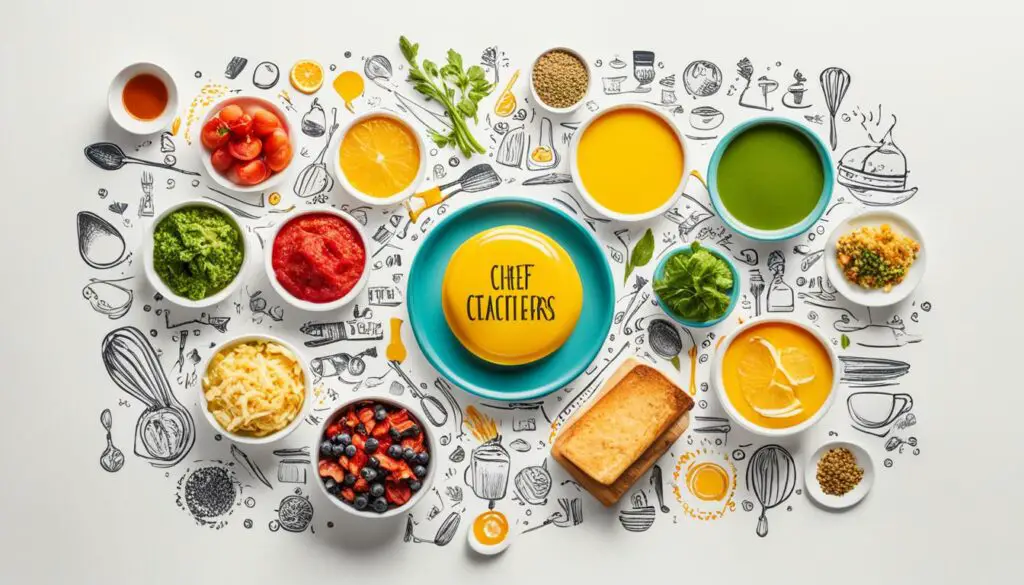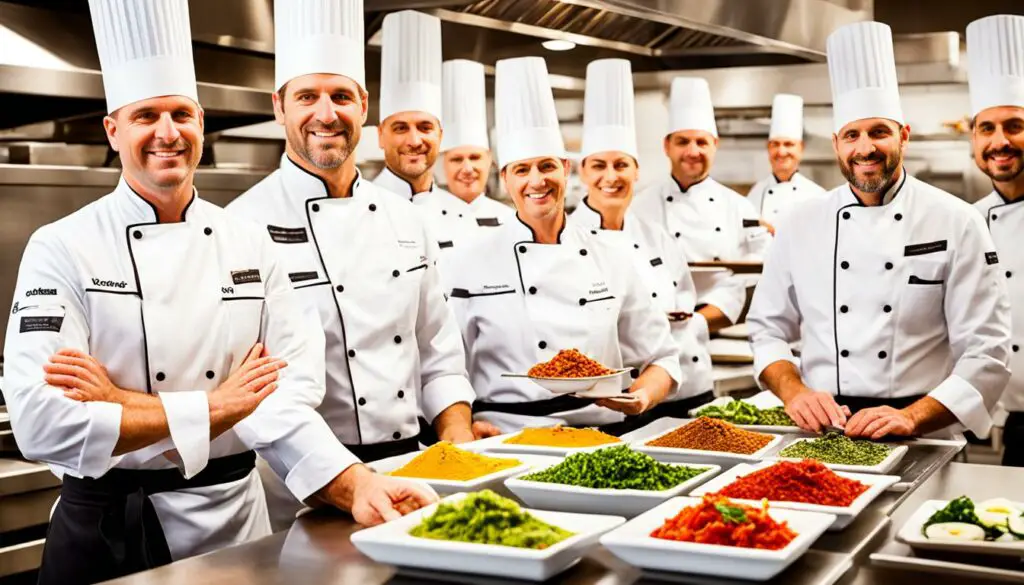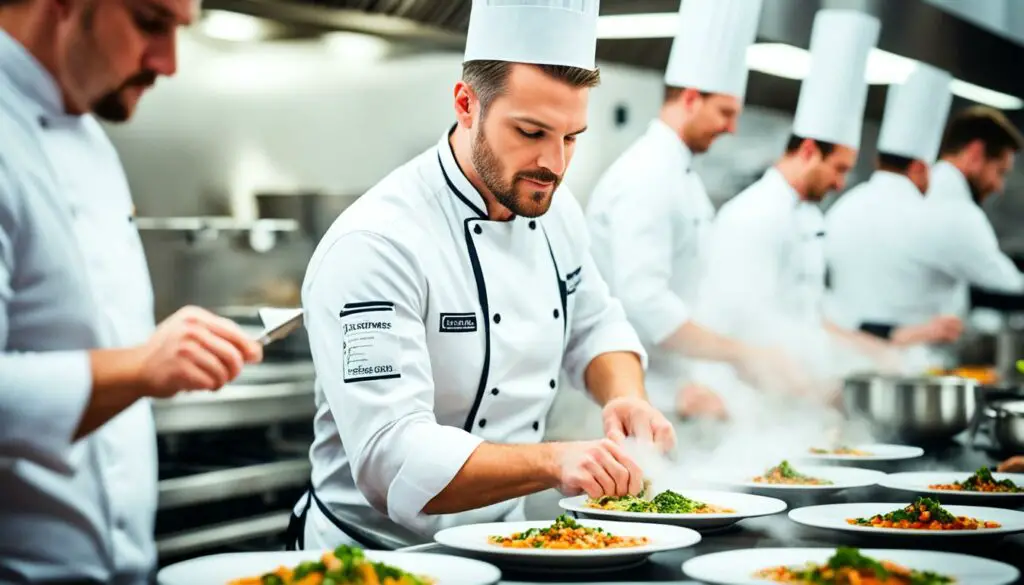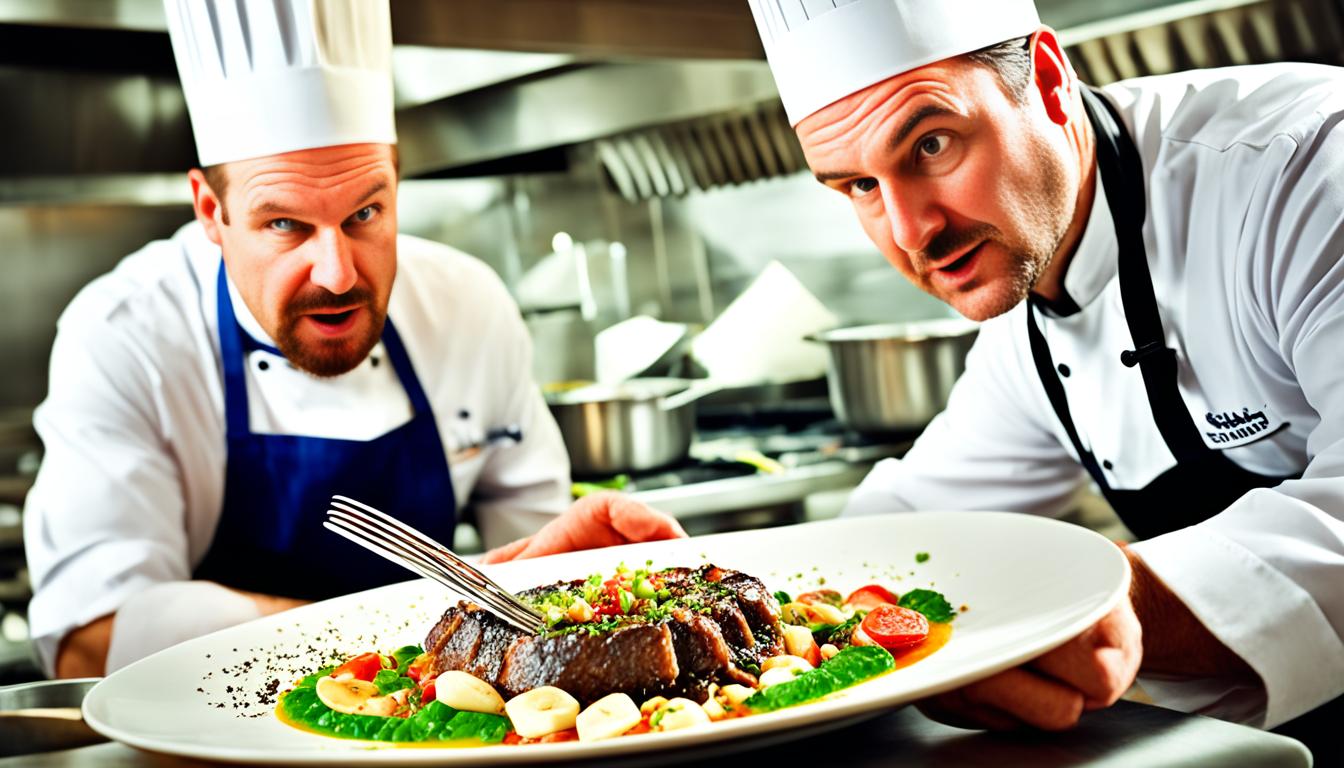Originally posted on February 10, 2024 @ 8:00 am
A public dispute in Brisbane between an award-winning restaurant and its former head chef highlights the issue of recipe ownership when a chef and restaurant part ways. This dilemma raises the question of who owns the rights to, and can market, a signature dish. The terms of the chef’s engagement and the ownership of intellectual property rights play a key role in determining recipe ownership.
Contents
- 1 Intellectual Property Rights and Recipe Protection
- 2 Terms of the Chef’s Engagement
- 3 Recipes Brought to the Restaurant
- 4 Executive Chef and Chef de Cuisine
- 5 Sous Chef
- 6 Chef du Partis (CDP)
- 7 Line Cooks
- 8 Grill and Saute Stations
- 9 Lack of Recipe Copyright Protection
- 10 The Challenge of Recipe Borrowing
- 11 Conclusion
- 12 FAQ
- 12.1 Who owns the rights to a dish, the chef or the restaurant?
- 12.2 What are the intellectual property rights associated with recipes?
- 12.3 How do the terms of the chef’s engagement affect recipe ownership?
- 12.4 Can a chef claim ownership of a recipe brought to a restaurant?
- 12.5 What is an executive chef and a chef de cuisine?
- 12.6 What is a sous chef?
- 12.7 What does a chef du partis (CDP) do?
- 12.8 What are line cooks responsible for?
- 12.9 What are the grill and saute stations?
- 12.10 Are recipes well-protected by copyright law?
- 12.11 What are the challenges faced by recipe creators?
- 12.12 What are the key factors in the issue of recipe ownership?
- 13 Source Links
Key Takeaways:
- Ownership of recipes can be contentious when a chef and restaurant separate.
- Intellectual property rights and contract terms impact recipe ownership.
- Copyright law offers limited protection for recipes in Australia.
- The chef’s engagement terms can establish recipe ownership.
- Protection of recipes as trade secrets requires confidentiality.
Intellectual Property Rights and Recipe Protection

When it comes to recipe ownership, understanding intellectual property rights is crucial. In Australia, copyright law provides limited protection for recipes. While the written form of a recipe can be protected, this only covers the exact expression of the recipe and not the substance itself. This means that someone can create a similar recipe without infringing on copyright if they use different wording or measurements.
Obtaining patent protection for recipes is also challenging unless they are truly unique or novel. In most cases, recipes do not meet the necessary criteria for patentability. However, there is another avenue for protection: trade secrets.
In order for a recipe to be protected as a trade secret, it needs to remain confidential. This means that the recipe must not be publicly disclosed or readily available to others. It is advisable for chefs to keep their recipes secret and limit access to them in order to maintain their trade secret status.
However, ensuring recipe attribution and protecting recipe copyrights poses significant challenges for chefs, especially in a restaurant setting.
A restaurant may argue that the recipes created by its chefs are the restaurant’s intellectual property, as they were developed and used within the scope of employment. This can complicate matters when a chef wants to claim ownership or seek attribution for their recipes.
As the culinary world continues to grapple with the issue of recipe ownership, it becomes increasingly important for chefs and restaurants to establish clear agreements regarding intellectual property rights. Without a comprehensive understanding of these rights, chefs may find it difficult to protect their creative contributions in the kitchen.
| Recipe Protection | Level of Protection |
|---|---|
| Copyright | Protects the exact expression of the recipe, not the substance |
| Patent | Difficult to obtain unless recipes are unique or novel |
| Trade Secret | Requires recipe to remain confidential |
In the next section, we will explore how the terms of a chef’s engagement with a restaurant can further complicate the issue of recipe ownership and intellectual property rights.
Terms of the Chef’s Engagement

The terms of the chef’s engagement by the restaurant play a crucial role in determining recipe ownership. Employment agreements often include clauses stating that any intellectual property created by the employee during their employment is owned by the employer. These intellectual property clauses establish that the chef’s recipes are the property of the restaurant.
If the chef alleges that they created the recipe outside of their employment or the contract is silent on ownership, it may complicate the issue. In such cases, the burden of proof may fall on the chef to demonstrate that the recipe was developed independently and not in the scope of their employment.
“Ownership of intellectual property is a critical aspect of the chef’s engagement. The intellectual property clauses in the employment agreement determine who has the rights to the recipes created during the chef’s tenure.”
It’s important for both chefs and restaurants to carefully negotiate and define the ownership of intellectual property rights in their contracts. By clearly addressing this issue, potential conflicts and disputes over recipe ownership can be avoided.
“The terms of the chef’s engagement can have significant implications for recipe ownership. It is essential for chefs and restaurants to establish clear guidelines regarding intellectual property rights to prevent future conflicts.”
Recipes Brought to the Restaurant
When a chef brings a recipe to a restaurant without using the restaurant’s equipment or ingredients, they may argue that the recipe remains their own. However, the restaurant can challenge this assertion by proving that the chef freely shared the recipe with others or made no effort to protect its secrecy. The ease of reverse-engineering the recipe or its generic nature can also impact whether it constitutes a trade secret.
While a chef may claim ownership of their recipes brought to a restaurant, there are several factors that can influence the determination of recipe ownership. The actions taken by the chef to protect the recipe’s secrecy and the specific characteristics of the recipe itself play crucial roles in this determination. Let’s take a closer look at these factors:
One important aspect that can impact recipe ownership is the extent to which the chef freely shares the recipe with others. If the chef has openly shared the recipe with colleagues, fellow chefs, or the general public, it weakens their claim to exclusive ownership. The more widely disseminated a recipe is, the more difficult it becomes for the chef to maintain sole ownership.
2. Efforts to Protect Secrecy
A chef who wishes to assert ownership of their recipe should take reasonable steps to protect its secrecy. This may include keeping the recipe confidential, limiting access to the recipe, and implementing non-disclosure agreements with staff members. Documentation of the recipe’s confidentiality measures can help strengthen the chef’s claim to ownership.
3. Reverse-Engineering Potential
The ease with which a recipe can be reverse-engineered can also impact its status as a trade secret. If the recipe is easily replicated by other chefs or if its ingredients and techniques are commonly known in the culinary industry, it may be challenging for the chef to establish the recipe as a unique creation deserving of ownership.
Considering these factors, it is essential for chefs to carefully evaluate the nature of their recipes, the extent of their efforts to protect them, and the level of exclusivity they wish to maintain when bringing recipes to a restaurant.
“Protecting the secrecy and uniqueness of a recipe is crucial for a chef who wants to establish ownership. By taking proactive measures to keep the recipe confidential and minimizing its shareability, chefs can strengthen their claim to exclusive ownership of their culinary creations.”
The ability to prove ownership of recipes brought to a restaurant relies on the chef’s ability to demonstrate that they have taken steps to protect and maintain the secrecy and exclusivity of their creations. Without adequate measures in place, such as non-disclosure agreements or keeping the recipe under lock and key, the chef’s claim to ownership may be at risk.
Next, let’s explore the various roles and responsibilities within a professional kitchen hierarchy in the culinary industry.
Executive Chef and Chef de Cuisine

The kitchen hierarchy is structured with various roles, each holding different levels of authority and responsibility. Two significant positions in a culinary team are the executive chef and the chef de cuisine.
The executive chef is the head chef, responsible for overseeing multiple kitchens or an entire restaurant group. Their role goes far beyond cooking, as they also manage the business aspects of the culinary operation. Executive chefs are known for their exceptional culinary skills and excellent leadership abilities.
On the other hand, the chef de cuisine is in charge of the day-to-day operations in a specific kitchen. They work closely with the executive chef, ensuring smooth workflow, managing the culinary team, and maintaining the high standards set by the executive chef. The chef de cuisine acts as the liaison between the chefs and other kitchen staff.
These positions represent the pinnacle of the kitchen hierarchy, where culinary mastery and leadership converge. The executive chef and chef de cuisine work together to create exceptional dining experiences while maintaining efficient kitchen operations.
Here is a breakdown of the key responsibilities of each position:
- Executive Chef:
- Oversee multiple kitchens or an entire restaurant group
- Create menus and recipes
- Manage culinary staff
- Ensure high-quality food production
- Monitor inventory and control costs
- Maintain food safety and sanitation standards
- Manage day-to-day operations in a specific kitchen
- Supervise kitchen staff and assign tasks
- Ensure food quality and consistency
- Collaborate with the executive chef on menu development
- Maintain kitchen organization and cleanliness
- Manage inventory and control costs
These roles play a crucial role in the success of a restaurant by maintaining culinary excellence, efficient workflow, and a cohesive kitchen team.
Quote:
“As an executive chef, my goal is not only to create exceptional dishes but also to inspire and lead my team to culinary excellence.”
Sous Chef

A sous chef plays a crucial role in the kitchen hierarchy, serving as the chef’s right hand. With a high level of trust and mutual respect, the sous chef supports and assists the chef in overseeing kitchen operations. While the chef is away, the sous chef takes charge, ensuring the smooth running of the kitchen.
The sous chef is not only responsible for supervising and coordinating the kitchen staff but also contributes to menu planning, recipe development, and food quality control. Their extensive knowledge and expertise make them invaluable in maintaining consistency and excellence in culinary creations.
A sous chef is often a highly skilled line cook who has earned the respect and admiration of their colleagues through their hard work and dedication. They possess excellent culinary skills and a deep understanding of ingredients, flavors, and cooking techniques.
In addition to their technical expertise, sous chefs also possess strong leadership and communication skills. They must effectively delegate tasks, provide guidance to kitchen staff, and ensure a cohesive and efficient workflow.
“The role of a sous chef goes beyond executing recipes. It requires a strong sense of teamwork, adaptability, and the ability to thrive in a fast-paced and demanding environment.” – Chef Emily Thompson
As the right hand of the chef, a sous chef plays a vital role in maintaining the integrity and success of the kitchen. Their contributions are instrumental in upholding the chef’s vision, ensuring a high standard of culinary excellence.
Chef du Partis (CDP)

A chef du partis, also known as a team lead, is an integral role in larger kitchens for station coordination. They are responsible for ensuring that their assigned station operates smoothly and efficiently during service. The CDP curates daily prep lists and delegates tasks to the cooks working under them. With their expertise and leadership skills, they play a crucial role in coordinating the actions of their station.
The chef du partis serves as a team lead, overseeing a specific station or section in the kitchen. They are highly skilled in their area of expertise and have a deep understanding of the techniques and requirements of their station. Their role is pivotal in maintaining consistency and quality in the dishes prepared at their station.
One of the key responsibilities of a chef du partis is to ensure the smooth execution of all orders from their designated station. This involves effective communication with other team members, such as the sous chef and line cooks, to ensure timely preparation and delivery of each dish.
Additionally, the chef du partis is responsible for coordinating the production schedule for their station. This includes managing ingredient quantities, monitoring inventory, and ensuring that all necessary ingredients and tools are readily available.
Key Responsibilities of a Chef du Partis:
- Coordinating and overseeing the assigned station
- Curating daily prep lists for the station
- Delegating tasks to the cooks working under them
- Ensuring smooth communication and coordination between team members
- Managing ingredient quantities and monitoring inventory
“The success of a well-run kitchen depends on the efficient coordination of different stations, and the chef du partis plays a vital role in ensuring that their station operates smoothly and delivers exceptional dishes to the customers.”
Working closely with the executive chef, sous chef, and line cooks, the chef du partis contributes to the overall success of the kitchen. Their attention to detail, leadership skills, and ability to coordinate actions make them an indispensable part of the culinary team.
Line Cooks
Line cooks are the soldiers of the kitchen. They are the backbone of any restaurant, responsible for cooking the food and executing the dishes with precision and skill. Considered the unsung heroes of the culinary world, line cooks work tirelessly behind the scenes to ensure that every plate that leaves the kitchen is a masterpiece.
As soldiers in the kitchen, line cooks play a vital role in the success of a service. They handle the intense pressure, fast-paced environment, and the demand for consistent high-quality dishes. Their ability to handle multiple orders simultaneously, maintain impeccable timing, and execute complex recipes is a testament to their talent and dedication.
Line cooks often start their culinary journey at the bottom and work their way up through the ranks. They acquire extensive knowledge and experience by working under experienced chefs and mastering various cooking techniques. Their skills are honed through repetition and practice, allowing them to excel in their roles.
Within the kitchen hierarchy, line cooks are the soldiers who bring the chef’s vision to life. They work closely with the sous chef and chef de partie to ensure smooth operations in their assigned stations. Communication and coordination are key as they collaborate with other team members to deliver flawlessly executed dishes.
The skill and performance of line cooks are highly regarded among professionals in the culinary industry. Their ability to consistently deliver exceptional dishes under pressure speaks volumes about their culinary expertise. Line cooks are valued not only for their technical skills but also for their ability to adapt, problem-solve, and maintain composure in the face of challenges.
Table: Average Salaries of Line Cooks in the United States
| Experience Level | Average Annual Salary |
|---|---|
| Entry-level | $25,000 – $35,000 |
| Experienced | $35,000 – $45,000 |
| Senior | $45,000 – $55,000 |
Despite the demanding nature of their work, line cooks are passionate about their craft and take pride in the dishes they create. Their dedication and hard work contribute significantly to the overall dining experience, making them an indispensable part of any successful kitchen.
Grill and Saute Stations
In a bustling kitchen, the grill and saute stations are crucial components where line cooks showcase their skills and expertise. These stations play a vital role in preparing a variety of dishes, each requiring unique techniques and attention to detail. Let’s explore the responsibilities and challenges associated with these stations.
The Grill Station: Sizzling Creations
At the grill station, line cooks take charge of cooking items that are grilled to perfection. Whether it’s succulent steaks, juicy burgers, or flame-kissed vegetables, this station is where the magic happens.
Mastering the grill requires precision in controlling temperatures, understanding cooking times, and achieving those coveted grill marks. The skillful management of heat and the ability to bring out the best flavors from the ingredients are essential.
“The grill station is like my own personal stage. I love the sizzle and the aroma of perfectly seared meats. It’s where flavors come alive and where I can truly showcase my grilling skills.” – Emily Martinez, Grill Station Chef
The Saute Station: A Symphony of Pans
While the grill station sizzles, the saute station dances with pans and ingredients, creating dishes cooked with finesse. From sauteed vegetables to aromatic stir-fries and delicate seafood, this station requires impeccable coordination and multitasking.
The saute station demands quick decision-making, as ingredients are rapidly tossed and transformed into delectable creations. With precise control over heat levels, line cooks must navigate the fine line between caramelization and burning, while ensuring the flavors meld harmoniously.
“Saute is the heart and soul of the kitchen. It’s where I get to infuse flavors, unleash creativity, and make dishes that bring smiles to diners’ faces. Every sauteed dish tells a story.” – Michael Stevens, Saute Station Chef
Line Cooks: Masters of the Stations
Line cooks are the culinary soldiers who bring the grill and saute stations to life. Assigned to specific stations based on their expertise and experience, they shoulder the responsibility of executing dishes with precision and finesse. Their performance at these stations indicates their proficiency in the kitchen and their ability to deliver consistent, high-quality dishes.
Line cooks at the grill station and saute station must work in harmony, coordinating their efforts to ensure a seamless flow. Excellent communication, adaptability, and attention to detail are crucial in meeting the demands of a fast-paced kitchen environment.
As line cooks progress in their culinary journey, they may rotate stations to further develop their skills and broaden their expertise, mastering different techniques and diversifying their culinary repertoire.
Let’s hear from Emma Wilson, a veteran line cook, about her experience in the kitchen:
“Working at the grill and saute stations has taught me discipline, precision, and the art of balancing flavors. It’s an intense yet rewarding environment that pushes me to constantly improve. Each day, I learn something new and strive to create dishes that delight our guests.” – Emma Wilson, Line Cook
With the grill and saute stations as their domain, line cooks skillfully navigate the intense heat, expertly manipulating flavors, and bringing culinary creations to life. Together, their expertise and dedication make the kitchen a haven of unforgettable meals.
Lack of Recipe Copyright Protection
Despite U.S. copyright law protecting various creative works, the realm of recipes remains relatively unprotected. Recipe creators often face significant challenges in proving unauthorized copying and protecting their intellectual property. Unlike other forms of creative expression, recipes lack comprehensive copyright protection.
The difficulty in asserting recipe copyright stems from the specific elements required for legal action. In some cases, small details, such as specific wording in the method or headnote, can potentially prevent successful legal claims. This challenge further contributes to the complex issue of recipe ownership in the culinary world.
Recipe borrowing is a prevalent challenge faced by authors of original recipes. Without strong copyright protection, recipe creators often find their work borrowed or copied without proper attribution or credit. This lack of recipe copyright protection hampers the ability of creators to assert their intellectual property rights and receive due recognition for their original work.
“Recipes are like opinions. Everyone has their own, but not everyone credits the original source.”
In the culinary industry, the practice of borrowing recipes without proper attribution has become a common occurrence. This situation reinforces the need for recipe copyright protection and highlights the importance of recipe attribution to acknowledge the creators behind these culinary creations.
To understand the significance of recipe attribution, it is essential to recognize the effort, creativity, and expertise that goes into developing a unique recipe. Recipe creators invest time and expertise in crafting flavorful combinations, innovative techniques, and distinctive presentations. Proper recipe attribution is a way to acknowledge and respect their creative contributions.
Why Recipe Attribution Matters
Recipe attribution not only acknowledges the original creator but also serves as a way to build trust and encourage further recipe development. By giving credit where it is due, recipe attribution fosters a culture of creativity, collaboration, and respect within the culinary community.
Furthermore, recipe attribution provides a way for aspiring chefs and home cooks to learn from established professionals. By knowing the original sources, aspiring chefs can explore the culinary journey of their favorite chefs, study different flavor profiles, and gain insights into various cooking techniques.
A complete and detailed table showcasing the importance of recipe attribution and the challenges faced by recipe creators will be included in this section. The table will illustrate how recipe attribution benefits the culinary industry and the consequences of neglecting proper attribution.
| Benefits of Recipe Attribution | Consequences of Neglecting Recipe Attribution |
|---|---|
| 1. Recognizes and honors the creativity of recipe creators. | 1. Lack of recognition and credit for recipe creators. |
| 2. Fosters a culture of collaboration and respect in the culinary community. | 2. Discourages recipe creators from sharing their innovative ideas. |
| 3. Enables aspiring chefs to learn from established professionals. | 3. Limits the growth of culinary knowledge and innovation. |
Proper recipe attribution plays a fundamental role in maintaining the integrity and growth of the culinary industry. It ensures that recipe creators receive the recognition they deserve while encouraging a vibrant and collaborative culinary community.
The Challenge of Recipe Borrowing
Recipe creators often encounter situations where their recipes are borrowed or copied without proper credit. This can lead to frustration and a lack of recognition for their original work. Copyright law may not provide sufficient protection for these instances, leaving recipe creators with limited options for asserting their rights.
The act of recipe borrowing involves taking someone else’s recipe and using it as one’s own without giving credit to the original creator. While recipes are often shared and adapted in the culinary world, it is essential to acknowledge the source and give credit where it is due. However, this is not always the case, and recipe creators may find their hard work and creativity going unnoticed or even being profited from by others.
One of the main challenges in addressing recipe borrowing is the lack of clear guidelines and regulations surrounding recipe ownership in the culinary industry. Unlike other creative works that are protected by copyright law, recipes have limited legal protection, making it difficult to pursue legal action against those who borrow or copy recipes without permission.
“Recipe creators often encounter situations where their recipes are borrowed or copied without proper credit.”
Additionally, proving the act of recipe borrowing can be challenging. Many recipes consist of common techniques and ingredient combinations, making it difficult to establish ownership or originality. Even when there are unique elements in a recipe, such as a specific flavor pairing or a creative cooking method, it can still be challenging to assert ownership without concrete evidence of the recipe’s origin and the unauthorized use of it.
The lack of credit for recipes not only impacts the recognition and reputation of recipe creators but also undermines the integrity of the culinary industry as a whole. Proper credit and attribution are essential in fostering a culture of creativity, respect, and innovation in the culinary community. When recipes are borrowed without acknowledgment, it diminishes the value of the original creator’s contribution and can discourage future recipe development and sharing.
Recipe creators must explore alternative strategies for protecting their recipes and asserting their rights in the absence of comprehensive legal frameworks. This includes methods such as documenting the creation process, keeping detailed records of recipe development, and establishing an online presence to showcase their original work. Creating a strong brand and reputation can also deter others from borrowing or copying recipes without permission.
Examples of Recipe Borrowing
Here are a few examples that highlight the challenges faced by recipe creators when their recipes are borrowed without credit:
| Example | Scenario |
|---|---|
| 1 | A popular food blogger creates a unique and innovative recipe, which quickly gains attention and praise from readers. However, within weeks, several other food bloggers post the exact same recipe on their blogs without acknowledging the original creator. |
| 2 | A renowned chef unveils a signature dish at their restaurant, featuring a combination of flavors and techniques that have never been seen before. Soon after, other restaurants in the area start offering a similar dish on their menus, clearly inspired by the chef’s creation. |
| 3 | A cookbook author publishes a recipe book showcasing their original recipes. A few months later, a competing author releases a similar recipe book containing almost identical recipes, leading to concerns of recipe copying and plagiarism. |
While these examples illustrate the challenges faced by recipe creators, they also highlight the importance of addressing recipe borrowing and promoting ethical practices within the culinary industry.
In the next section, we will further explore the overarching issues in recipe ownership and the diverse perspectives surrounding this complex matter.
Conclusion
The culinary industry presents a complex landscape when it comes to recipe ownership. Factors such as employment terms, intellectual property rights, and creative attribution all contribute to this issue. Unfortunately, the lack of recipe copyright protection adds another layer of challenge for recipe creators seeking ownership and recognition for their work.
In this industry, where innovation and creativity are highly valued, it is crucial to establish clear guidelines and agreements regarding recipe ownership. Chefs and restaurants can benefit from incorporating specific clauses in their employment contracts that address the intellectual property created during the chef’s tenure with the restaurant.
While copyright law may not fully protect recipes, chefs and culinary professionals can explore alternative strategies to assert ownership. Trade secrets can offer a level of protection, ensuring the recipe remains confidential. Additionally, accurate recipe attribution and proper credit within the culinary community can foster a culture of respect and recognition for recipe creators.
Understanding the hierarchy and titles within a kitchen is also essential in determining who ultimately owns a dish. Chefs at different levels, such as executive chefs, sous chefs, and line cooks, play distinct roles in the culinary process. Recognizing the creative contributions of each individual is vital for sustaining a fair and supportive environment in the culinary industry.
FAQ
Who owns the rights to a dish, the chef or the restaurant?
The ownership of a dish’s recipe depends on various factors such as the chef’s engagement terms and intellectual property rights. In some cases, the restaurant owns the recipe, while in others, the chef may retain ownership.
What are the intellectual property rights associated with recipes?
Recipes have limited copyright protection, covering only the exact expression of the recipe, not its substance. Patent protection is difficult to obtain, and recipes can be protected as trade secrets if kept confidential.
How do the terms of the chef’s engagement affect recipe ownership?
Employment agreements often state that any intellectual property created by an employee is owned by the employer. If the chef’s contract includes this clause, the restaurant owns the recipes. If it is silent on ownership or the recipe was created outside of employment, ownership can be more complicated.
Can a chef claim ownership of a recipe brought to a restaurant?
If a chef brings a recipe to a restaurant using their own equipment and ingredients, they may argue that it remains their own. However, the restaurant can challenge this if the chef freely shared the recipe or made no effort to protect its secrecy.
What is an executive chef and a chef de cuisine?
An executive chef oversees multiple kitchens or a restaurant group, while a chef de cuisine manages day-to-day operations in a specific kitchen. Both roles hold significant authority and responsibility in the culinary hierarchy.
What is a sous chef?
A sous chef is the second-in-command in a kitchen, serving as the chef’s right hand. They have a high level of trust and responsibility, overseeing kitchen operations in the chef’s absence.
What does a chef du partis (CDP) do?
A chef du partis, also known as a team lead, coordinates a specific station in larger kitchens. They ensure the station runs smoothly, delegate tasks, and play a crucial role in coordinating actions during service.
What are line cooks responsible for?
Line cooks are responsible for cooking the food and executing the dishes. They are the backbone of the kitchen staff and play a vital role in the success of a service.
What are the grill and saute stations?
The grill station handles grilled items like steaks and burgers, while the saute station cooks dishes in pans. Line cooks are assigned to specific stations based on their expertise.
Are recipes well-protected by copyright law?
Recipes are not as well-protected as other creative works. Specific wording in the recipe may prevent legal action, and the lack of recipe copyright protection complicates the issue of recipe ownership.
What are the challenges faced by recipe creators?
Recipe creators often face situations where their recipes are borrowed or copied without proper credit. Copyright law may not provide adequate protection, leaving creators with limited options to assert their rights.
What are the key factors in the issue of recipe ownership?
The complexity of recipe ownership in the culinary industry involves factors such as employment terms, intellectual property rights, and creative attribution. The lack of recipe copyright protection adds further challenges for recipe creators.
Source Links
- https://www.nytimes.com/2021/11/29/dining/recipe-theft-cookbook-plagiarism.html
- https://saltandlove.blog/2018/06/20/is-the-chef-sous-chef-or-cdc-in-charge-a-breakdown-of-whose-who-who-does-what-in-kitchens/
- https://www.claytonutz.com/insights/2017/may/but-i-want-to-keep-making-it-who-owns-a-signature-dish-when-the-chef-responsible-moves-on








